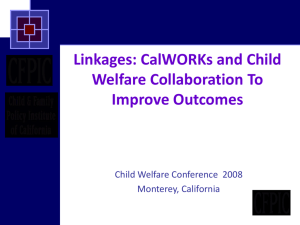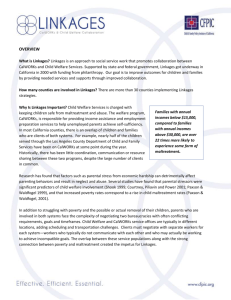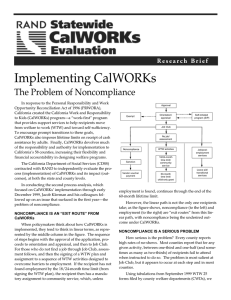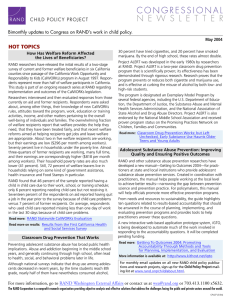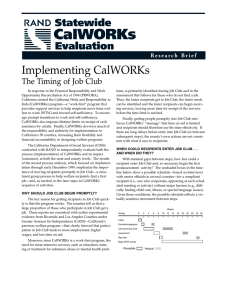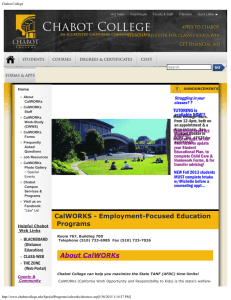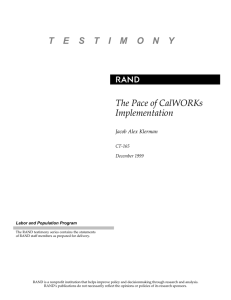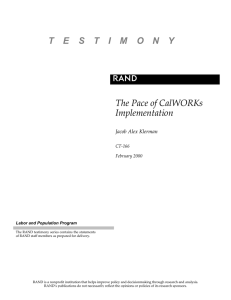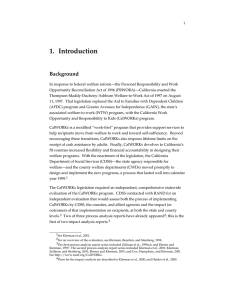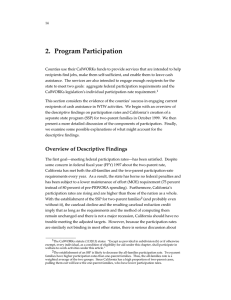Implementing CalWORKs The Need for Added Capacity
advertisement
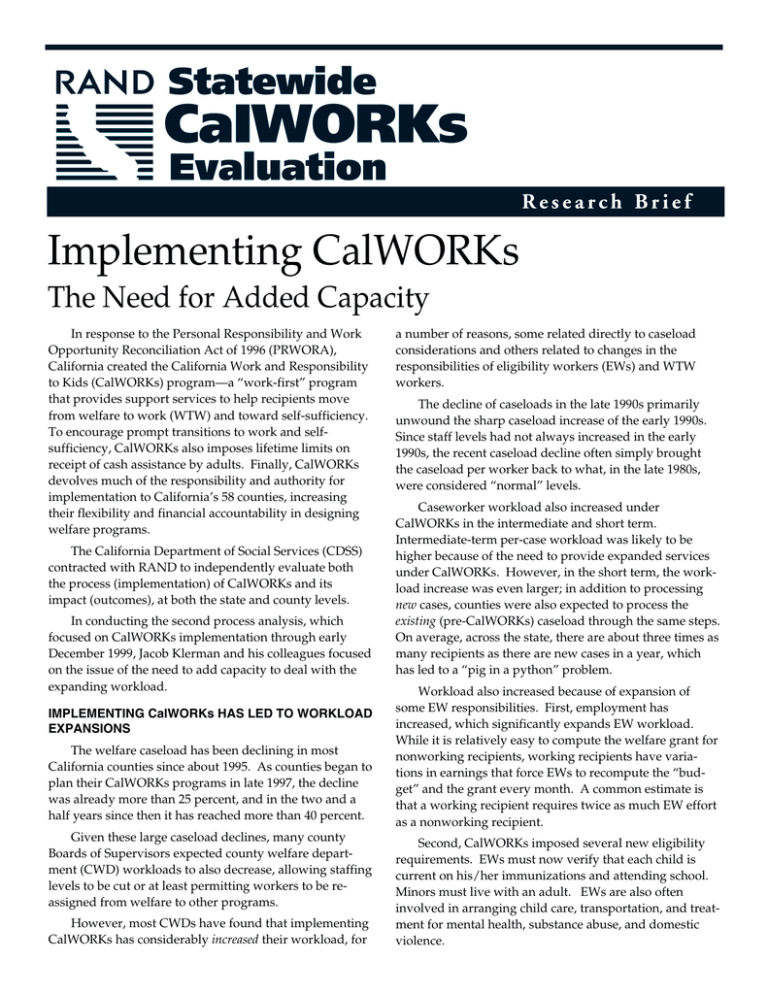
Research Brief Implementing CalWORKs The Need for Added Capacity In response to the Personal Responsibility and Work Opportunity Reconciliation Act of 1996 (PRWORA), California created the California Work and Responsibility to Kids (CalWORKs) program—a “work-first” program that provides support services to help recipients move from welfare to work (WTW) and toward self-sufficiency. To encourage prompt transitions to work and selfsufficiency, CalWORKs also imposes lifetime limits on receipt of cash assistance by adults. Finally, CalWORKs devolves much of the responsibility and authority for implementation to California’s 58 counties, increasing their flexibility and financial accountability in designing welfare programs. The California Department of Social Services (CDSS) contracted with RAND to independently evaluate both the process (implementation) of CalWORKs and its impact (outcomes), at both the state and county levels. In conducting the second process analysis, which focused on CalWORKs implementation through early December 1999, Jacob Klerman and his colleagues focused on the issue of the need to add capacity to deal with the expanding workload. IMPLEMENTING CalWORKs HAS LED TO WORKLOAD EXPANSIONS The welfare caseload has been declining in most California counties since about 1995. As counties began to plan their CalWORKs programs in late 1997, the decline was already more than 25 percent, and in the two and a half years since then it has reached more than 40 percent. Given these large caseload declines, many county Boards of Supervisors expected county welfare department (CWD) workloads to also decrease, allowing staffing levels to be cut or at least permitting workers to be reassigned from welfare to other programs. However, most CWDs have found that implementing CalWORKs has considerably increased their workload, for a number of reasons, some related directly to caseload considerations and others related to changes in the responsibilities of eligibility workers (EWs) and WTW workers. The decline of caseloads in the late 1990s primarily unwound the sharp caseload increase of the early 1990s. Since staff levels had not always increased in the early 1990s, the recent caseload decline often simply brought the caseload per worker back to what, in the late 1980s, were considered “normal” levels. Caseworker workload also increased under CalWORKs in the intermediate and short term. Intermediate-term per-case workload was likely to be higher because of the need to provide expanded services under CalWORKs. However, in the short term, the workload increase was even larger; in addition to processing new cases, counties were also expected to process the existing (pre-CalWORKs) caseload through the same steps. On average, across the state, there are about three times as many recipients as there are new cases in a year, which has led to a “pig in a python” problem. Workload also increased because of expansion of some EW responsibilities. First, employment has increased, which significantly expands EW workload. While it is relatively easy to compute the welfare grant for nonworking recipients, working recipients have variations in earnings that force EWs to recompute the “budget” and the grant every month. A common estimate is that a working recipient requires twice as much EW effort as a nonworking recipient. Second, CalWORKs imposed several new eligibility requirements. EWs must now verify that each child is current on his/her immunizations and attending school. Minors must live with an adult. EWs are also often involved in arranging child care, transportation, and treatment for mental health, substance abuse, and domestic violence. Third, the number of noncompliant cases has sharply increased—to about 25 percent statewide. For such cases, EWs must implement a multistep conciliation process, moving recipients through official notification, to sanction (cutting their benefit), to vendor voucher payment, and— as appropriate—rolling back these steps when a recipient comes back into compliance. Finally, workload has increased because of expansions in the WTW program. Under CalWORKs, a Greater Avenues to Independence program that often included only a quarter of all adults receiving assistance was made nearly universal. Nearly all new recipients were to move through a sequence of steps: orientation, appraisal, Job Club, assessment, and a sequence of post-assessment WTW activities (as shown in the middle column in the figure). These steps were to begin immediately after Approval Orientation/ appraisal Exempt Self-initiated program (SIP) Job Club No job/ assessment Noncompliance WTW activities Sanction 18/24-month time limit/ community service Vendor voucher payment Job/postemployment services 60-month time limit/ child-only grant Leave aid/ transitional services approval of the aid application and were to continue until the recipient got a job and left aid, and for some services (at county option) for a year or two thereafter. In most counties, the number of participants in WTW programs more than doubled, and the intensity of activities per participant (and required WTW worker input) also increased. EXPANSIONS REQUIRE ADDING CAPACITY The end result of the expanded workload is that CWDs have had to add considerable additional “capac- ity”—either additional staff or additional contracts (or both) to provide services to welfare recipients. How can CWDs determine whether their current staffing levels are appropriate? Doing so requires being able to make the following assessments in terms of the CalWORKs program model shown in the figure. First, CWDs need to determine whether all existing cases have been processed through the steps of the model (the middle column) and how long it is taking a new case to reach Job Club and the first post-assessment WTW activity. Delays can indicate insufficient capacity. As shown in the bottom left column, noncompliance is one exit route, and CWDs need to decide how they will deal with noncompliant cases; home visits are a popular strategy but are very staff-intensive. Employment (the right bottom column) is another exit route. CalWORKs allows counties to provide services to employed recipients and to continue services after recipients leave aid (to keep them from returning to cash aid). If this work is being done by county employees, it increases the need for additional staff. In addition, although CalWORKs is a “work-first” model, as shown by the emphases in the figure, it provides funds for dealing with recipients who have significant barriers to work—in particular, mental health problems, substance abuse, and domestic violence. Identifying and arranging treatment for such conditions is timeintensive—it takes time to deal with each recipient and to adequately train workers. Finally, beyond the staffing issues related to the model shown in the figure, the ways in which counties organize to provide services have staffing implications. For example, many counties are moving toward team concepts in which high-risk families are handled by teams of employees from welfare, child welfare staff, probation, and public health. Arranging for such complicated handoffs requires additional staff time. If cases are moving slowly through the steps or if some steps are not being done (e.g., processing noncompliant cases), staffing levels may need to be increased. If, however, the short-term surge has been handled and the caseload continues to decline, there may be an opportunity to reassign staff or cut positions. The research summarized in this Research Brief was carried out within RAND’s Labor & Population Program. Research results are described in detail in MR-1177-CDSS, Welfare Reform in California: State and County Implementation of CalWORKs in the Second Year, Jacob Klerman et al., 2000 (416 pp., $25) and its accompanying Executive Summary, MR-1177/1-CDSS, (28 pp., $8). Both documents are available electronically at http://www.rand.org/CalWORKs or through RAND Distribution Services (Telephone: 310-451-7002; FAX 310-451-6915; Internet: order@rand.org). Abstracts of RAND documents may be viewed on the World Wide Web (http://www/rand.org). RAND® is a registered trademark. RAND is a nonprofit institution that seeks to improve policy and decisionmaking through research and analysis; its publications do not necessarily reflect the opinions or policies of its research sponsors. R 1700 Main Street, P.O. Box 2138, Santa Monica, California 90407-2138 • Telephone 310-393-0411 • FAX 310-393-4818 1200 South Hayes Street, Arlington, VA 22202-5050 • Telephone 703-413-1100 • FAX 703-413-8111 RB-5040 (2000)
